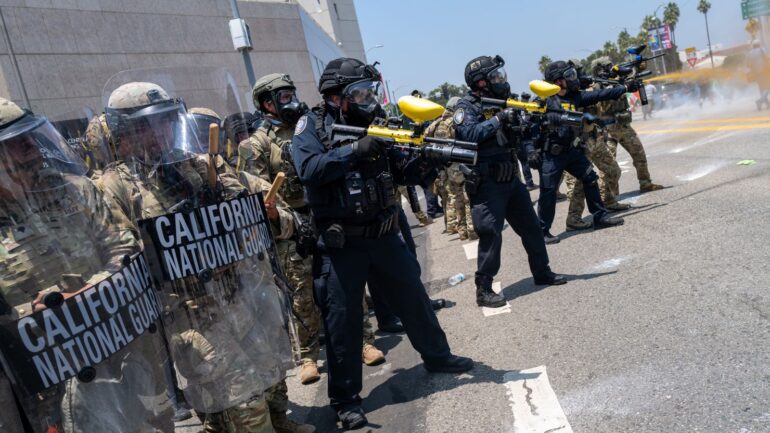Los Angeles, a city known for its diversity, has become a battleground of unrest as thousands of protesters clash with law enforcement over President Donald Trump’s aggressive immigration crackdown. On Sunday, June 8, 2025, tensions boiled over when Trump deployed the National Guard to the city, a move that sparked outrage, freeway blockades, and burning self-driving cars. The protests, now in their third day, highlight deep divisions over immigration policy and federal overreach, leaving residents, officials, and the nation watching closely.
A City on Edge
The protests began Friday after federal agents conducted sweeping immigration raids across Los Angeles, arresting over 100 immigrants in places like the fashion district and a Home Depot parking lot. By Saturday, demonstrations spread to Paramount and Compton, heavily Latino areas, where protesters tried to block Border Patrol vehicles, hurling rocks and concrete. Federal agents responded with tear gas and pepper balls, escalating the conflict.
Sunday’s protests centered on downtown Los Angeles, particularly outside the Metropolitan Detention Center, where some detained immigrants were held. Crowds chanted “shame” and “go home” at National Guard troops, who stood shoulder-to-shoulder with riot shields and long guns. When some protesters approached the troops, police fired smoke canisters and crowd-control munitions, declaring the assembly unlawful. Demonstrators then blocked the 101 Freeway, halting traffic until state patrol cleared the roadway. Nearby, four Waymo self-driving cars were set ablaze, sending thick black smoke into the sky.
Trump’s Unprecedented Move
The deployment of approximately 300 National Guard troops, authorized by Trump without the consent of California Governor Gavin Newsom, marks a rare instance of federal intervention in state affairs. The last such activation without a governor’s request was in 1965, when President Lyndon B. Johnson sent troops to protect civil rights marchers in Alabama. Trump justified the move by citing a “rebellion or danger of a rebellion” against federal authority, vowing “very strong law and order.” He hinted at expanding troop deployments, stating, “We’re gonna have troops everywhere.”
Trump’s rhetoric has been uncompromising. Speaking to reporters in New Jersey, he called protesters “violent people” and warned that state officials obstructing deportations could face charges. The administration’s stance was echoed by Assistant Homeland Security Secretary Tricia McLaughlin, who accused California leaders of “defending heinous illegal alien criminals.” Defense Secretary Pete Hegseth even threatened to deploy active-duty Marines if the unrest continues, with 500 Marines on standby at Twentynine Palms.
California Pushes Back
Governor Newsom and Los Angeles Mayor Karen Bass have sharply criticized Trump’s actions. Newsom called the Guard deployment a “serious breach of state sovereignty” in a letter to Trump, demanding their withdrawal. Bass, speaking at a press conference, accused the administration of provoking “chaos” for political gain, stating, “This isn’t about public safety.” Both leaders argue that the federal presence is inflaming tensions rather than resolving them.
Former Vice President Kamala Harris, a Los Angeles resident, condemned the raids and Guard deployment as a “cruel, calculated agenda to spread panic and division.” Vermont Senator Bernie Sanders went further, warning that Trump’s actions signal a slide toward “authoritarianism.” In contrast, House Speaker Mike Johnson defended Trump, claiming Newsom’s failure to control the protests necessitated federal intervention.
A Broader Impact
The unrest has rippled beyond Los Angeles. In San Francisco, police arrested about 60 protesters on Sunday after declaring their demonstration unlawful. China’s consulate in Los Angeles issued a warning to its citizens to avoid crowded areas and monitor official announcements, citing safety concerns. The protests, while significant, remain smaller than historic events like the Watts riots, the Rodney King unrest, or the 2020 demonstrations against police violence, when Newsom himself requested federal assistance.
The human toll is evident. Among those arrested was a prominent union leader accused of impeding law enforcement during the protests. Demonstrators, some waving Mexican flags and holding signs, have faced tear gas, rubber bullets, and flash bangs. Meanwhile, the immigrant community lives in fear as federal agents continue their operations.
What’s Next?
As Los Angeles grapples with this crisis, the nation faces larger questions about immigration policy, federal power, and civil liberties. Trump’s hardline approach shows no signs of softening, while California’s leaders remain defiant. The protests have exposed raw emotions—anger, fear, and resolve—on all sides. For now, the streets of Los Angeles remain tense, with the world watching to see whether dialogue or further confrontation will shape the path forward.
